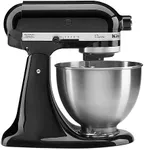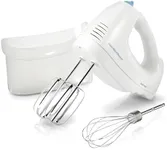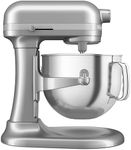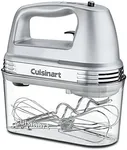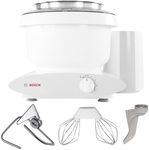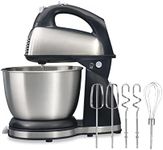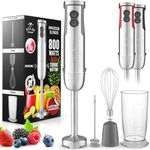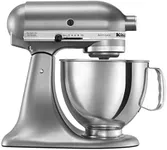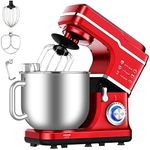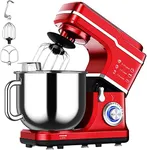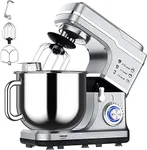Buying Guide for the Best Food Mixers
Choosing the right food mixer can make a significant difference in your kitchen, whether you're a casual baker or a professional chef. A food mixer can help you save time and effort when preparing various recipes, from simple doughs to complex batters. To find the best fit for you, it's essential to understand the key specifications and how they align with your cooking needs.Power (Wattage)Power, measured in watts, indicates the strength of the mixer's motor. This spec is important because a more powerful motor can handle tougher doughs and larger quantities of ingredients without straining. Mixers typically range from 250 watts to over 1000 watts. For light tasks like whipping cream or mixing cake batter, a mixer with 250-500 watts is sufficient. For heavier tasks like kneading bread dough, look for a mixer with at least 500 watts. Choose based on the types of recipes you frequently prepare.
CapacityCapacity refers to the size of the mixer's bowl, usually measured in liters or quarts. This is important because it determines how much you can mix at one time. Smaller mixers have bowls around 2-3 liters, suitable for small batches or single recipes. Larger mixers can have bowls up to 6 liters or more, ideal for large families or batch cooking. Consider your typical batch size and how often you cook for larger groups when choosing the right capacity.
Speed SettingsSpeed settings allow you to control how fast the mixer operates. This is important for achieving the right consistency for different recipes. Mixers can have anywhere from 3 to 12 speed settings. Basic mixers with 3-5 speeds are good for general use, while more advanced models with 6-12 speeds offer greater precision for specific tasks like slow mixing or high-speed whipping. Think about the variety of recipes you make and whether you need fine control over mixing speeds.
AttachmentsAttachments are additional tools that come with the mixer, such as dough hooks, beaters, and whisks. These are important because they expand the functionality of the mixer. Basic models usually come with standard beaters and a whisk, while more advanced models may include dough hooks, paddle attachments, and even pasta makers or meat grinders. Consider what types of recipes you plan to make and choose a mixer with the appropriate attachments to meet your needs.
Build Quality and MaterialBuild quality and material refer to the construction of the mixer and the materials used. This is important for durability and longevity. Mixers can be made from plastic, metal, or a combination of both. Plastic mixers are lighter and often less expensive but may not be as durable. Metal mixers are more robust and can handle heavy use but are usually heavier and more expensive. Consider how often you will use the mixer and whether you need a more durable model for frequent, heavy-duty use.
Ease of CleaningEase of cleaning refers to how simple it is to clean the mixer and its components. This is important for maintaining hygiene and convenience. Mixers with detachable parts that are dishwasher safe are easier to clean. Some models have smooth surfaces and fewer crevices, making them easier to wipe down. Consider how much time you want to spend on cleaning and whether you prefer a model with dishwasher-safe parts.
Size and WeightSize and weight refer to the physical dimensions and heaviness of the mixer. This is important for storage and ease of use. Larger, heavier mixers may be more stable and powerful but can be difficult to move and store. Smaller, lighter mixers are easier to handle and store but may not be as powerful. Consider your kitchen space and how often you will need to move the mixer when choosing the right size and weight.
